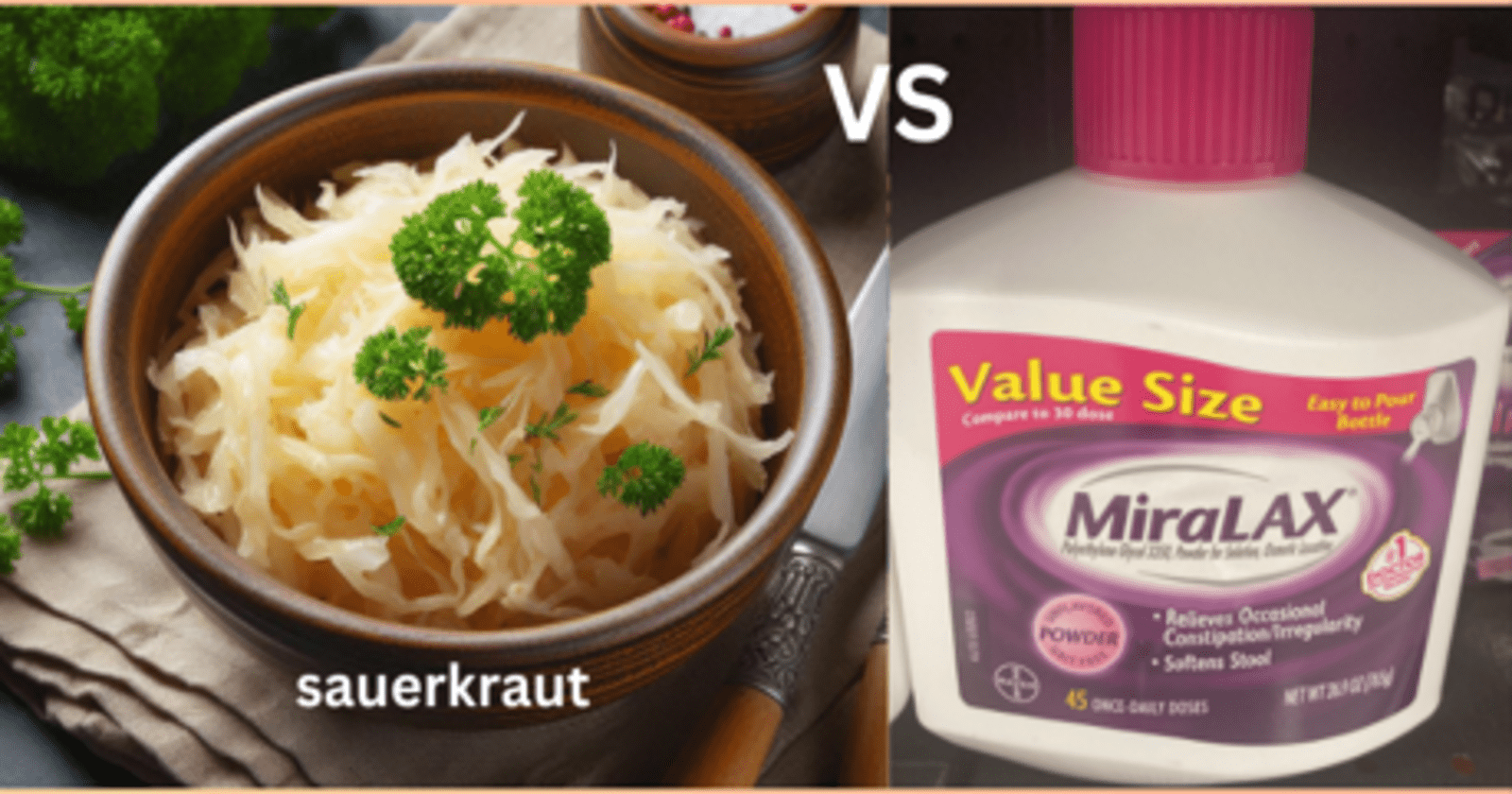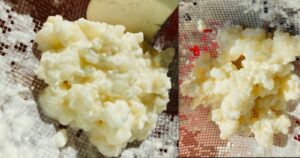Probiotic vs Miralax: Which is Better for Constipation? Discover the benefits and differences between probiotics and Miralax for relieving constipation. Learn how each option works, their effectiveness, potential side effects, and which might be the best choice for your digestive health.
Probiotics are live microorganisms, typically bacteria or yeasts that are similar to the beneficial microorganisms (gut microbiota) naturally found in the human gut.
Miralax is a polyethylene glycol 3350 (PEG) drug, an osmotic laxative, that work by pulling water into the colon thus soften stool and increase bowel movement.
MiraLAX is a laxative formulated to work without relying on substances that are metabolized by the body or that cause irritation.
| Probiotics | Miralax |
|---|---|
| – Live microorganisms, usually bacteria | – Draws water into the colon, softening stool |
| – Provide health benefits when consumed adequately | – Makes it easier to pass stools |
| – Replenish gut with beneficial bacteria | – Short-term relief for constipation |
| – Regulate bowel movements and improve digestion | – Usually produces bowel movement within 1-3 days |
| – May vary in effectiveness depending on strain and person | – Widely available over-the-counter |
| – Generally safe for most people | – safe for short-term use in most cases |
| – Potential preventive benefits against constipation | – May lead to dependence or electrolyte imbalances if used excessively |
Is Miralax or Probiotic More Effective for Constipation?
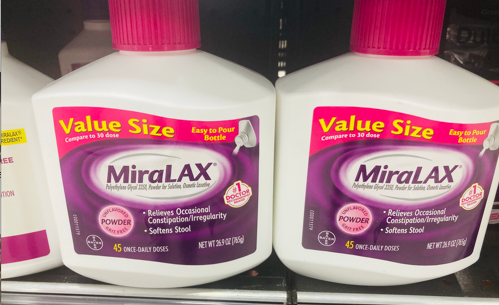
Miralax:
- Best for Immediate Relief: If you need quick relief from constipation, Miralax is generally more effective due to its fast-acting nature, usually working within 1-3 days.
- Short-term Solution: Ideal for short-term use to address acute constipation episodes.
Probiotics:
- Best for Long-term Gut Health: Probiotics are more effective for improving overall gut health and addressing chronic constipation by balancing gut microbiota and enhancing intestinal motility.

- Long-term Benefits: Suitable for long-term use, providing additional health benefits such as immune support and reduced inflammation.
The effectiveness of Miralax versus probiotics for constipation depends on individual needs and circumstances. For immediate relief, Miralax is typically more effective.
However, for long-term management and overall digestive health, probiotics are a better option. It may also be beneficial to consult a healthcare provider to determine the most appropriate treatment for your specific condition.
How dose Probiotic vs Miralax work in the gut
Probiotic and Miralax both can contribute to gastrointestinal health, they address different issues and can even be used together in some cases, depending on individual needs and circumstances.
How Probiotics work
Probiotics work by replenishing and balancing the natural microorganisms, mainly bacteria, in the gut, which collectively form what’s known as the gut microbiota.
This microbiota plays a crucial role in various aspects of health, including digestion, immune function, and even mental well-being.
1. Replenishing Gut Microbiota:
The gut is home to trillions of microorganisms, including bacteria, viruses, and fungi, collectively known as the gut microbiota. These microorganisms play essential roles in maintaining gut health and overall well-being.
Factors such as diet, antibiotics, stress, and illness can disrupt the balance of gut microbiota, leading to digestive issues like constipation.
Probiotics contain live microorganisms, primarily beneficial bacteria strains such as Lactobacillus and Bifidobacterium, which are similar to the beneficial bacteria naturally found in the gut.

By consuming probiotics, individuals can replenish and restore the balance of beneficial bacteria in the gut, promoting overall gut health and function
2. Enhancing Digestive Function:
Beneficial bacteria in the gut help break down food, ferment fiber, and produce essential nutrients such as short-chain fatty acids and vitamins.
Probiotics can enhance digestive function by aiding in the breakdown and absorption of nutrients from food, which can contribute to more regular bowel movements and alleviate constipation.
Additionally, certain probiotic strains may produce substances that stimulate peristalsis, the rhythmic muscle contractions that move food and waste through the digestive tract, thus promoting bowel regularity.
3. Modulating Immune Response:
The gut microbiota plays a crucial role in regulating the immune system, influencing the body’s ability to fight off infections and maintain immune balance
Probiotics can modulate the immune response by interacting with immune cells in the gut-associated lymphoid tissue (GALT) and promoting the production of anti-inflammatory compounds.
By supporting a healthy balance of gut bacteria, probiotics may help reduce inflammation in the gut, which can contribute to improved digestive function and overall well-being.
4. Restoring Gut Barrier Function
The gut lining serves as a barrier that prevents harmful substances, such as toxins and pathogens, from entering the bloodstream while allowing nutrients to be absorbed.
Disruptions in gut microbiota balance can compromise the integrity of the gut barrier, leading to increased permeability (leaky gut) and inflammation.
Probiotics have been shown to strengthen the gut barrier by promoting the production of mucus, enhancing tight junction integrity, and competing with pathogenic bacteria for resources and attachment sites along the intestinal lining.
How dose Miralax work
Miralax is a commonly used over-the-counter laxative medication primarily composed of polyethylene glycol (PEG). Its mechanism of action is quite interesting and effective for relieving constipation.
1. Osmotic Effect: The main way Miralax works is through its osmotic effect. Osmosis is the movement of water across a semi-permeable membrane from an area of lower solute concentration to an area of higher solute concentration.
When Miralax is ingested, the polyethylene glycol molecules are not absorbed by the intestines. Instead, they remain in the gastrointestinal tract, where they draw water into the colon through osmosis.
2. Increased Water Content in the Bowel: By drawing water into the colon, Miralax softens the stool, making it easier to pass.
This increased water content in the bowel helps to loosen and bulk up the stool, relieving constipation.
3. Stimulation of Bowel Movement: The softened stool and the increased volume of water in the colon stimulate the muscles of the intestines, promoting peristalsis—the wave-like contractions of the intestines that move stool through the digestive tract. This helps to facilitate bowel movements.
4. Minimal Systemic Absorption: One of the advantages of Miralax is that it is minimally absorbed into the bloodstream.
This means it primarily stays in the gastrointestinal tract, exerting its effects locally without significantly impacting other parts of the body. It also reduces the risk of systemic side effects.
5. Gentle and Effective: Miralax is known for being gentle yet effective. It typically produces a bowel movement within 1 to 3 days after starting treatment.
The gentle nature of Miralax makes it suitable for long-term use under medical supervision for individuals who require ongoing management of constipation.
6. Non-Habit Forming: Because Miralax works locally in the gastrointestinal tract and does not cause dependency, it is considered non-habit forming.
This makes it a preferred choice for managing constipation, especially in cases where long-term treatment may be necessary.
Differences between Probiotics and Miralax
| Probiotics | Miralax (Polyethylene Glycol 3350) |
|---|---|
| Balances gut microbiota, enhances motility | Osmotic laxative, hydrates stool |
| Time to Effectiveness: Days to weeks | Time to Effectiveness: 1-3 days |
| Can be used long-term | Short-term use recommended |
| Generally mild, such as gas or bloating | Bloating, nausea, cramping, diarrhea |
| Improves overall gut health, immune support | Primarily relieves constipation, can lead to dehydration |
| Addresses gut microbiota imbalance | Does not address microbiota imbalance |
| Widely available, various strains | Over-the-counter, easy to use |
| Suitable for long-term gut health improvement | Suitable for quick relief of constipation |
Types & forms of probiotics
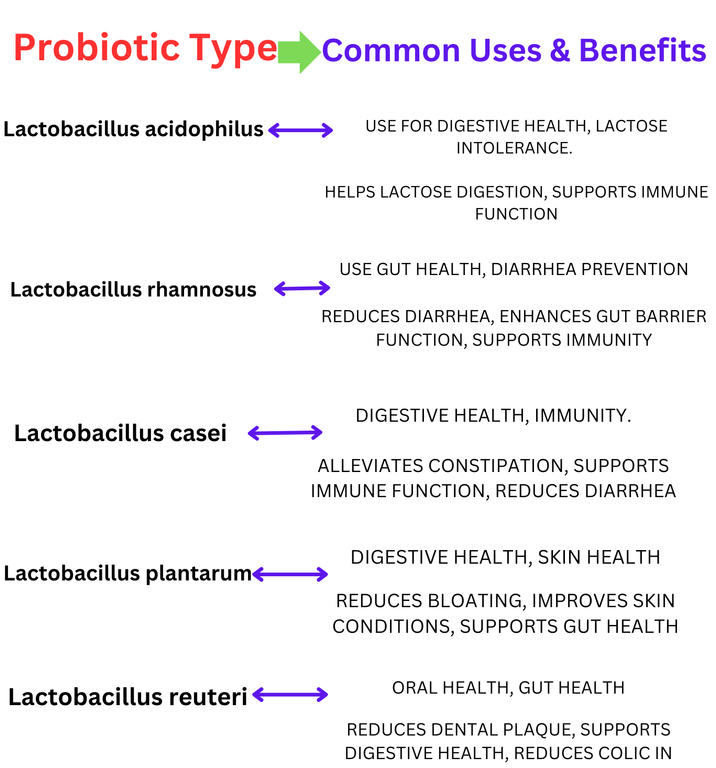


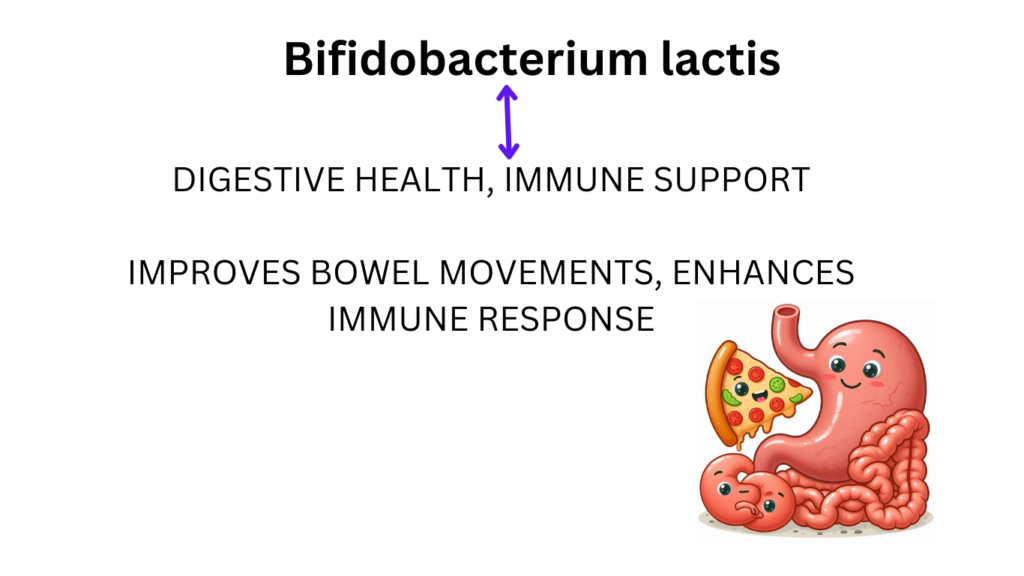

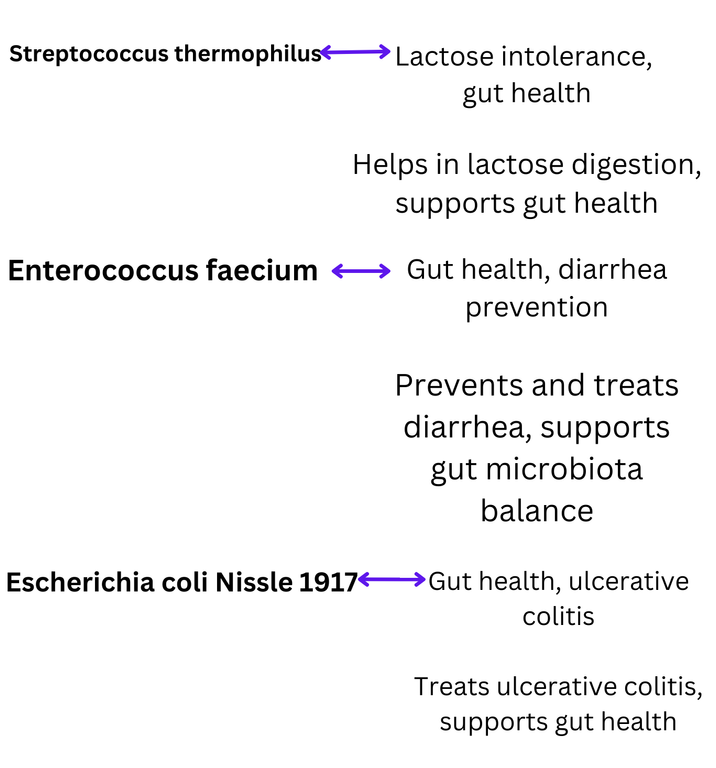
| Bacillus coagulans | Gut health, immunity Reduces irritable bowel syndrome (IBS) symptoms, enhances immune function |
| Bacillus subtilis | Digestive health, gut microbiota balance Supports gut health, reduces gastrointestinal discomfort |
| Pediococcus acidilactici | Fermentation, gut health Used in food fermentation, supports gut health |
Forms of Probiotics
- Capsules and Tablets:
- Encapsulated probiotics are convenient and ensure a specific dose. They often have enteric coatings to protect the probiotics from stomach acid, ensuring they reach the intestines.
2. Powders:
- Can be mixed with water, juice, or food. They offer flexibility in dosing and are suitable for people who have difficulty swallowing pills.
3. Yogurt and Fermented Dairy Products:
- Natural sources of probiotics, such as yogurt, kefir, and certain cheeses, which contain live cultures like Lactobacillus and Bifidobacterium.


4. Fermented Foods:
- Sauerkraut, kimchi, miso, and tempeh are rich in probiotics and also offer other nutritional benefits.


5. Probiotic Drinks:
- Beverages like kombucha and probiotic shots offer a convenient way to consume probiotics on the go.


6. Chewables and Gummies:
- Designed for children or adults who prefer not to swallow pills. These are flavored and easy to take but may contain added sugars.
MiraLAX Form
MiraLAX is a laxative used to treat constipation by drawing water into the bowels to soften stools and stimulate bowel movements. It comes primarily in the form of a powder.
MiraLAX Powder
- Powder Form:
- Description: MiraLAX is available as a powder that is mixed with liquid before ingestion.
- Usage: The powder is typically mixed with water, juice, or other beverages. A common dosage is 17 grams (about one heaping tablespoon) of powder mixed into 4-8 ounces of liquid.
- Advantages:
- Easy to adjust the dosage.
- Flavorless, so it can be mixed into various beverages without affecting the taste.
- Convenient for individuals who prefer not to swallow pills.
- Packaging: Usually available in bottles with a measuring cap or in single-dose packets for convenience.
Advantages of Probiotics vs miralax
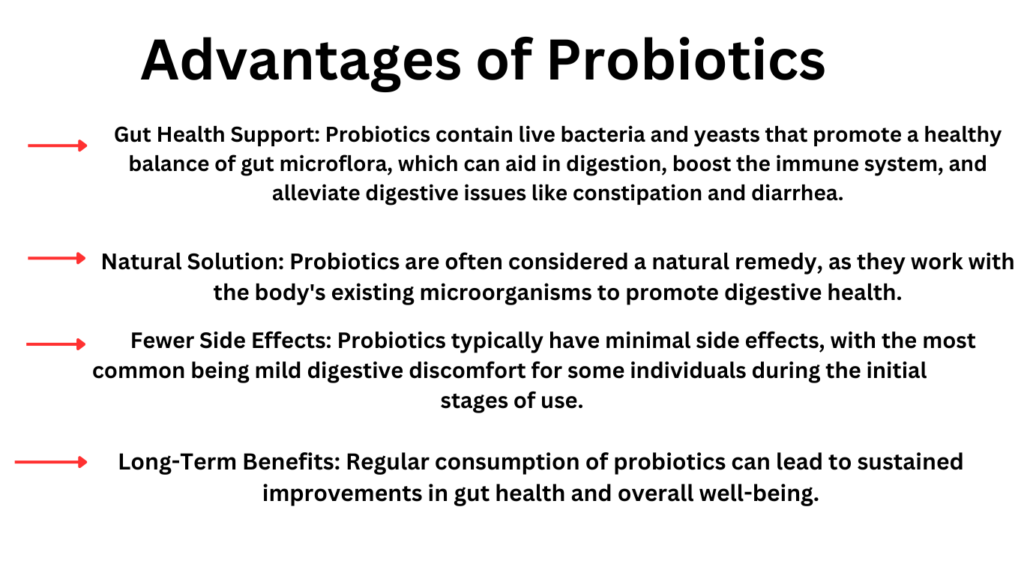

Dosage recommended for miralax
Miralax can be taken in Juice ,water coffee or tea.
| Age Group | Dosage Recommendations |
|---|---|
| 6 months – 1 year | Consult a pediatrician before use. |
| 1 – 4 years | 1/4 capful (6g ) dissolved in 4-8 oz of liquid daily. (1 teaspoon) |
| 5- 7years | 1/2 capful (8.g) dissolved in 8 oz of liquid daily. (2 teaspoon) |
| 8-16 years | 3/4 capful (12g) dissolved in 8oz of liquid daily. (4 teaspoon) |
| 17 years and older | 1 capful (17g) dissolved in 8 oz of liquid daily. |
- It’s essential to dissolve the powder in the recommended amount of liquid.
- Always follow the specific instructions provided by a healthcare professional or the product’s labeling.
- For children under the age of 6, consulting a pediatrician is crucial to determine the appropriate dosage and suitability.
- MiraLAX should not be used for more than 7 days unless directed by a doctor.
It might be preferable to take it in the morning to reduce the chance of needing a bowel movement during the night. Typically, MiraLAX induces a bowel movement within 1 to 4 days.
You can begin using MiraLAX as soon as you notice signs of constipation and continue with one dose daily until you feel relieved, but do not exceed 7 days unless advised by your doctor.
Common Side Effects of Probiotics & MiraLAX
Probiotics are generally considered safe for most people, but they can sometimes cause mild side effects, especially when first starting them. Common side effects include:
Common side effects of Probiotics
- Digestive Symptoms:
- Gas
- Bloating
- Diarrhea
- Stomach cramps
- Other Possible Side Effects:
- Increased thirst
- Constipation (less common)
- Allergic reactions (very rare, but possible, especially in individuals with severe allergies to specific strains or ingredients)
Common Side Effects of MiraLAX
MiraLAX (polyethylene glycol 3350) is a commonly used over-the-counter laxative for treating constipation. It is generally well-tolerated, but can cause some side effects, including:
- Digestive Symptoms:
- Bloating
- Gas
- Nausea
- Stomach cramps
- Diarrhea (especially if taken in large amounts)
2. Other Possible Side Effects:
- Allergic reactions (very rare)
- Dehydration (if not taken with adequate water)
Long-Term Safety Profiles
Probiotics:
- General Safety: Long-term use of probiotics is generally considered safe for most people, including children, adults, and the elderly. However, individuals with compromised immune systems or severe underlying health conditions should consult a healthcare provider before starting probiotics.
- Potential Risks:
- Overgrowth of bacteria in the intestines (SIBO – Small Intestinal Bacterial Overgrowth).
- Risk of infection in immunocompromised individuals.
- Potential for probiotic strains to cause systemic infections (extremely rare).
Long-term use of probiotics is usually safe but should be approached with caution in immunocompromised individuals.
MiraLAX should be used under medical supervision if required for long-term use to avoid potential risks such as electrolyte imbalance and dependency.
Identifying People Who Shouldn’t Take Probiotics
Probiotics are generally considered safe for most people, but there are specific populations who should exercise caution or avoid their use. Here are the key groups of individuals who should be cautious or avoid probiotics:
- Immunocompromised Individuals:
- People with weakened immune systems, such as those undergoing chemotherapy, organ transplant recipients, individuals with HIV/AIDS, or those on immunosuppressive medications, are at higher risk for infections, including sepsis, due to probiotic bacteria.
2. Critically Ill Patients:
- Those in intensive care units or with severe, acute illnesses should avoid probiotics due to the increased risk of infections and complications.
3. Patients with Short Bowel Syndrome:
- Individuals with significantly shortened intestines due to surgical removal may experience bacterial overgrowth and related complications when using probiotics.
4. Individuals with Severe Pancreatitis:
- Probiotics have been associated with increased mortality in some studies involving patients with severe acute pancreatitis, so they should be avoided in this population.
5. People with Severe Allergies:
- Individuals with severe allergies to components of probiotic supplements or the carriers used in the supplements should avoid them to prevent allergic reactions.
6. Neonates (Especially Preterm Infants):
- Preterm infants or those with very low birth weights are at risk for infections and should only use probiotics under strict medical supervision.
7. Individuals with Heart Valve Disease:
- There is a theoretical risk of endocarditis (infection of the heart lining) from probiotics, so people with heart valve issues should consult their healthcare provider before use.
8. Patients with Central Venous Catheters:
- Those with central venous catheters are at increased risk for bloodstream infections and should avoid probiotics to prevent possible infections.
Who should avoid or exercise caution when using MiraLAX:
- Individuals with Known or Suspected Bowel Obstruction:
- MiraLAX should not be used in individuals with a known or suspected bowel obstruction as it could worsen the condition or cause serious complications.
- People with Allergies to Polyethylene Glycol:
- Those who have a known hypersensitivity or allergy to polyethylene glycol should avoid using MiraLAX to prevent allergic reactions.
- Patients with Renal Impairment:
- Individuals with significant kidney problems should use MiraLAX cautiously, as there is a potential risk of electrolyte imbalances, particularly with prolonged use.
- People with Gastrointestinal Perforation:
- MiraLAX should not be used by individuals with a known or suspected gastrointestinal perforation (a hole in the wall of the gastrointestinal tract).
- Patients with Toxic Megacolon:
- This condition, often associated with inflammatory bowel diseases like ulcerative colitis, involves extreme dilation of the colon. Using MiraLAX could exacerbate this condition.
- Individuals with paralytic ileus:
- Those with ileus, a condition where the intestines do not move properly, should avoid MiraLAX as it could worsen the lack of movement in the intestines.
- Severe Dehydration:
- People who are severely dehydrated should avoid using MiraLAX, as it could potentially lead to further dehydration due to its osmotic effect.
- Children Under 17 Without Medical Advice:
- While MiraLAX is sometimes used off-label for children, it should only be done under the guidance of a healthcare provider to ensure appropriate dosing and monitoring.
- Pregnant and Breastfeeding Women:
- Although generally considered safe, pregnant and breastfeeding women should consult their healthcare provider before using MiraLAX to ensure it is appropriate for their specific situation.
- Individuals with Electrolyte Imbalances:
- Those with existing electrolyte disturbances should use MiraLAX cautiously, as it can cause or exacerbate electrolyte imbalances, particularly with long-term use.
For anyone considering the use of MiraLAX, especially those with underlying health conditions, it is essential to consult with a healthcare provider to determine if MiraLAX is appropriate and safe for their specific circumstances.
Resources
https://en.wikipedia.org/wiki/Probiotic
https://www.accessdata.fda.gov/drugsatfda_docs/label/1999/20698pi.pdf
